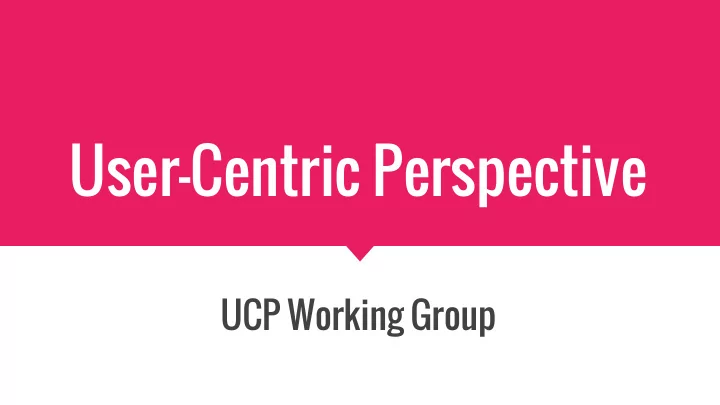

User-Centric Perspective UCP Working Group
Our approach to this theme - We started by defining concepts and terms we thought were relevant - We told stories/use cases of user-centric process models “in the wild” as well as counterexamples (we found way more counterexamples) - We found many links to the purpose of modeling - We shared our assessment of the literature to date and which gaps exist - We developed questions that we think are worth asking in research
The process of modeling ● The roles involved in ● modeling Many variables about ● What we know “the user” and “the model” (e.g., characteristics of the modeler)
Examples discussed of user-centric process modeling “in the wild” - The checklists always used in aviation - The evacuation procedures that are never meant to be used - Cooks that use or do not use recipes - Process modeling can be a way of knowledge management . It may not require a completely consistent repository but it is simply a way to explicate tacit knowledge - Often the value for users stems from the act of creating the model (ie the process of process modeling) more so than from the artefact (ie the model)
What we don’t know
What is user-centric process ● modeling? What is it not? What is the role of the user ● in user-centric modelling? What we Are there differences ● between models for user don’t know groups vs. individuals? What are relevant constructs ● for UPC? How do we observe and ● measure the constructs? Which of these have we not measured at all so far? What can we learn from how ● other fields regarding constructs and measuring?
Questions we think are worth asking in BPM research What would user-centric process modeling mean? What makes a ● process model user-centric? Do we actually need to make modeling user-centric? Do we need to involve users in modeling? Should we let the users model? Is the model the interface between the actual process and the ● user? Do we need this interface always and for all users? Can we create better ones? What can we learn about process models from the ways that users ● appropriate “process model-like” artefacts such as checklists, recipes, manuals etc? What happens when we don’t look at individual users but instead ● at collectives (groups, organizations, units, etc.)
Questions about Research Conduct What are the relevant constructs (comprehension, shared ● understanding, performance, engagement, utility, consensus, effort, purpose, value, etc.) How do we observe and measure them (interviews, questionnaires, ● model analysis, etc.)? Which of these have we not measured at all so far? How to link these constructs with the purpose of a model for a stakeholder? What can we learn from how other fields measure these or similar ● constructs? Which advances in methodologies could we utilize better? ● Which recommendations/prescriptions/design theories can we ● derive from this?
Suggestions for the BPM research community We suggest to develop a set of recommendations for BPM research ● conduct and reporting, such as Always identify and name the users or user groups in focus ○ Delineate the specific purpose of a model ○ Identify the relevant variables of interest ○ Clarify whether a study is about the model, about the ○ process being modeled or about the process of modeling itself Separate process design from process modeling ○
Suggestions ctd. We suggest to encourage modes of research that assist an ● understanding of “the user” (and in particular “groups” thereof), such as Ethnography / descriptive field studies ○ Inductive field studies ○ Qualitative research ○ Development of measurement scales for use in a BPM context ○ Convince a BPM-friendly journal to publish a special issue ● on user-centric BPM
Backup: for our continued discussion
Evolution of Emergent Processes Magic: Someone figures out how to do something, it is ● intransparent to outsiders - there is an unknown model Heuristic: Over time, rules/constraints/sequences emerge ● that achieve the outcome in a more consistent/predictable fashion - the model is a rough approximation Algorithm: The process can be described in a formal ● fashion, and repeated even by those unfamiliar with the domain - the model is detailed and precise The user community changes alongside this evolution
Personal processes without models (but modeling?)
Examples for existing research on user-centric process modeling Tangible BPM initiative (e.g., HPI & Stanford) Collaborative process modeling tools (e.g., Peter Rittgen, QUT, SAP) Human factors in BPM (e.g., HC-PAIS, work by Kathrin Figl) Work on process model reuse (WU Vienna, QUT and others) User-characteristics: creativity, experience, knowledge, cognitive load, learning style, cognitive effectiveness, expertise, self-efficacy, attitude, task preferences
The Formal Modeling Process Gather : Obtain information necessary to create a model ● Through interviews/questionnaires (asking SMEs to express themselves) ○ Through observation (human or mechanical) ○ Through reconstruction (mining) ○ Construct : Create the model ● Note: Sometimes this is the “use” of the model - create consensus ○ Use : Apply the model ● Note: Some models are created, but not enacted (example: evac plans) ○ Assess : Evaluate the utility of the model ● Question: What are good measures for utility? ○
The Roles Modeler ● Expert modelers versus domain experts vs. end users ○ Engineer ● Is the engineer the same as the modeler? ○ User ● ‘clerical’ workers (manipulate data according to fix rules of the ○ organisation, no addition of knowledge or insight - transactions) ‘knowledge’ workers (create new relationships, concepts, ideas, and ○ logical arguments - judgment, problem solving, new strategy) direct users (interact w/ model or system derived from model) ○ indirect users (obtain benefit from direct users’ model use) ○ Organization ●
Recommend
More recommend